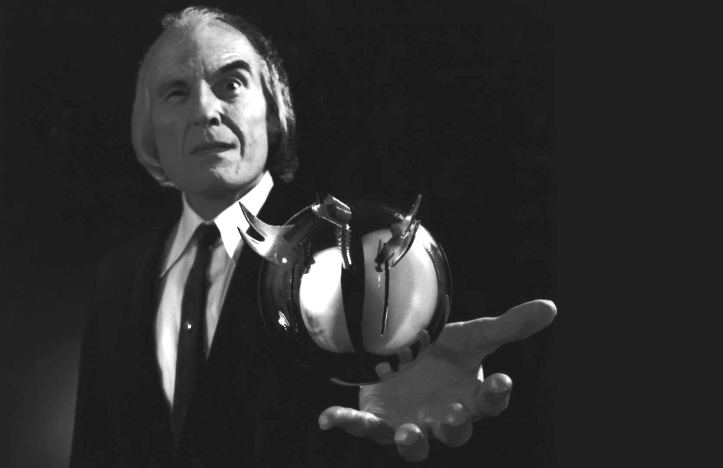One of my favorite movies is Phantasm, a 1979, low budget horror movie that has, over the years, turned into a cult classic. Back in 2000, I interviewed Angus Scrimm, who played the film’s towering villain, about why the film has endured for decades.

Text:
Phantasm’s notoriety – or lack thereof – can easily be summed up by Steven Romano.
“You walk up to people and say, ‘Ever heard of Phantasm?’ They’re like, ‘Huh?'” says Romano, organizer of a three-day “Phantasmania” convention held this spring in Austin. “Then if you say, ‘It was the movie with that flying silver ball that sucks your brain out,’ they’ll say, ‘Oh, yeah, I know that movie. It scared the hell out of me.'”
Thus is the aura surrounding the 1979 horror/sci-fi movie Phantasm, written and directed on a shoestring budget by Don Coscarelli. One of the first movies to successfully leave its viewers hanging in is-it-a-dream-or-reality limbo, Phantasm was also one of the first films to marry elements of science fiction with traditional creepy-crawly terror.
Angus Scrimm anchored the movie as the “Tall Man,” a menacing funeral home undertaker who resurrected dead bodies to use them as slaves on his home planet. A trio of guys – brothers Michael (played by Michael Baldwin) and Jody (Bill Thornbury) and their pony-tailed pal Reggie (Reggie Bannister) – caught wind of the scheme and tried to put an end to it. Three sequels later, they were still trying.
Phantasm was a mild success at the time, but a string of bad sequels and subsequent horror movies with bigger budgets and better special effects have all but erased the film from memory.
Yet there exists a circle of Phantasm fans and followers who have kept the series alive. They organize and flock to Phantasm conventions. They run Phantasm Web sites. They eagerly await the arrival of MGM’s release of Phantasm IV and re-release of Phantasm on DVD, both due Tuesday. And they pray for the day another sequel will be made (one is in the works).
All this fuss over a little horror movie? Out of all the frightening flicks to come out over the years, what makes it so special?
Fans and those associated with the series say it’s a combination of good timing, shock-value originality and the series’ strong sense of family bonding.
“Phantasm is one of the most unique horror movies to ever come out,” says Tony Timpone, editor in chief of Fangoria, a long-running magazine devoted to the horror and sci-fi industry. “I think a lot of people were struck by the incredible, unforgettable images – the silver balls, the Tall Man. Coscarelli really knew how to paint the screen with provocative images of horror.”
John Pagliardo, of Ringwood, N.J., who runs a fan Web site (http://members.aol.com/smallman666), says it’s the friendship/family-values facet that has attracted so many Phantasm-ites.
“Strip away the horror/sci-fi aspect and you have an underlying story of friendship and camaraderie that many people can identify with,” he says. “The horror story plays a critical role, as do the special effects, but the main attraction to the series is the characters. They grow on you and make you care what happens to them.”
So what does happen to them? In the first Phantasm movie, the parents of Mike and Jody are killed “in a car accident.” It is later revealed that Scrimm’s Tall Man character murdered them. Along with Reggie, the brothers hunt down the Tall Man, all the while trying to keep the Tall Man from hunting them down.
Eventually, though, the brothers lose. Jody is killed. As is Michael. And the Tall Man himself.
Or were they?
The characters die, then, in the sequels, come back to life at a hectic pace, keeping viewers guessing. The deaths and rebirths are chronicled in the many dream sequences, as well as flashbacks to the first installment, that run rampant throughout the series, further skewing what is real and what isn’t.
“It has a beautiful dreamlike quality to it that really unnerved me,” says Fangoria’s Timpone. “It was the first film to really weave in this whole “Is it a dream?” sequence into the action. You gotta remember, this was six years before Nightmare on Elm Street.“
Angus Scrimm, whose Tall Man character uses spiked silver balls that drill holes into his victims’ heads as his weapons of voice, says that timing is the main reason Phantasm became popular.
“It was 1979, when Halloween and Alien were relaunching the horror film,” he says. “The moment was right for an original horror movie like Phantasm.
“And it struck a chord, particularly with boys and girls who could identify with the character Mike,” Scrimm says. “Mike had just lost his parents. He was fearful of losing his brother. A lot of young people identified with that insecurity.”
And now, Scrimm says, those kids have grown up.
“It’s astonishing how many people come up to me and say, ‘You scared the blank out of me when I was 13 years old.’ Writers, film stars, people I meet at conventions, this is the movie that scared them when they were young. Phantasm was remarkably constructed to appeal to teens, and now those teens have grown up – but they’re still fans.”
Although it has certainly made its mark in pop culture, Phantasm did not boost the careers of any of its stars. The key actors are either not making movies or relegated to low-budget, straight-to-video horror flicks.
Thornbury has abandoned movies and teaches music at a high school in Fresno, Calif. Bannister has immersed himself in music and various environmental causes. Baldwin tinkers with low-budget, homemade movies.
As for Scrimm, he has been banished to the lowbrow-horror genre; he appears in movies that go directly to home video, if they come out at all. While Phantasm heightened his looming image, it has also limited him.
“Phantasm gave me a certain awareness in Hollywood, but it didn’t do very much for my career,” Scrimm says. “It’s a tough battle, trying to scratch your way out of the horror-movie ghetto. Hollywood looks at the horror-movie genre as one step above the porno industry.”
But the Phantasm universe is a comfortable place to exist, Scrimm says. And interest in it continues. Roger Avary, who won an Oscar for co-writing Pulp Fiction, is working on a script for a fifth installment, Scrimm says. And Romano is developing a comic-book series that has been endorsed by everyone in the Phantasm family.
Both projects will tap into topics Phantasm fans have come to expect: friendship, horror and, most important, mysticism.
“Phantasm exists without explanation. That’s part of the beauty of it,” Scrimm says. “It touches on psyche and fear, and those are things we can all relate to.”










